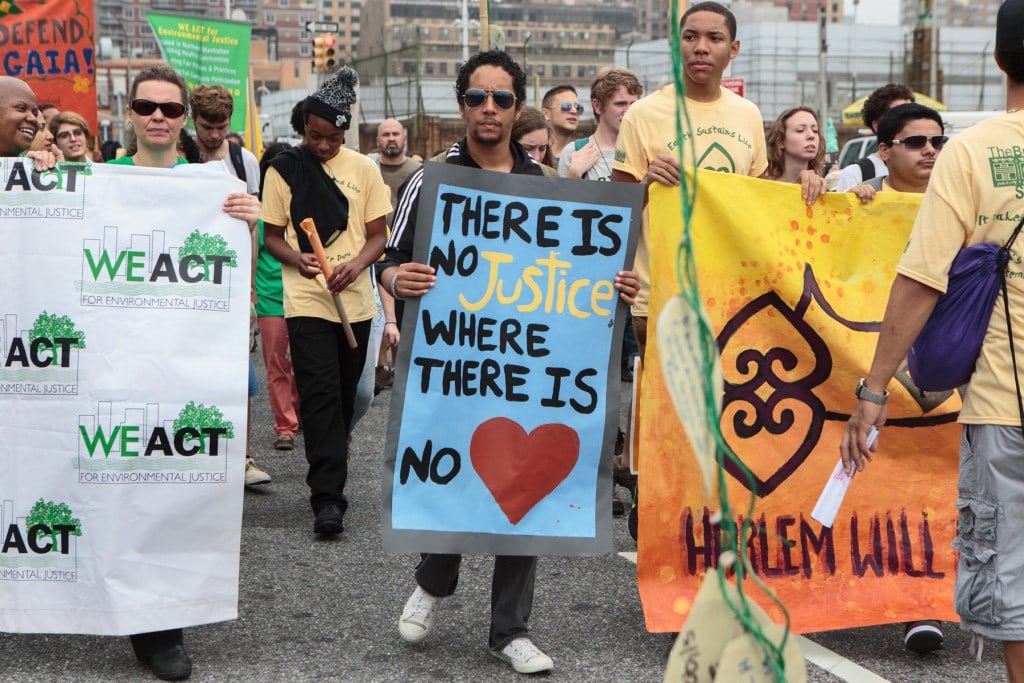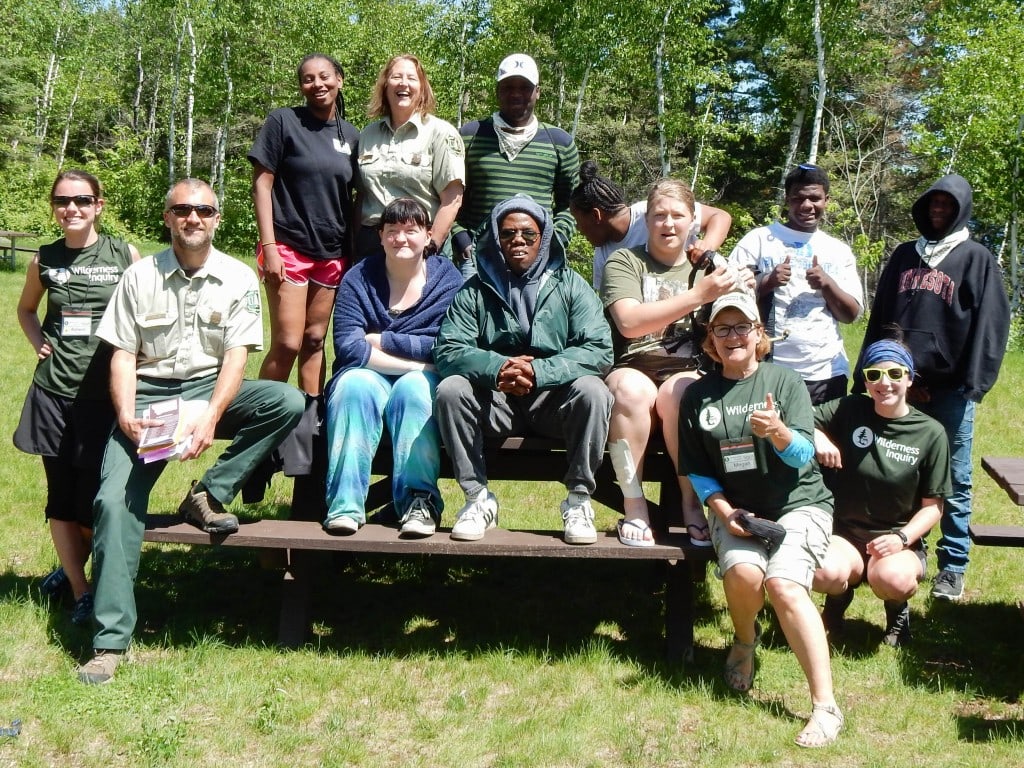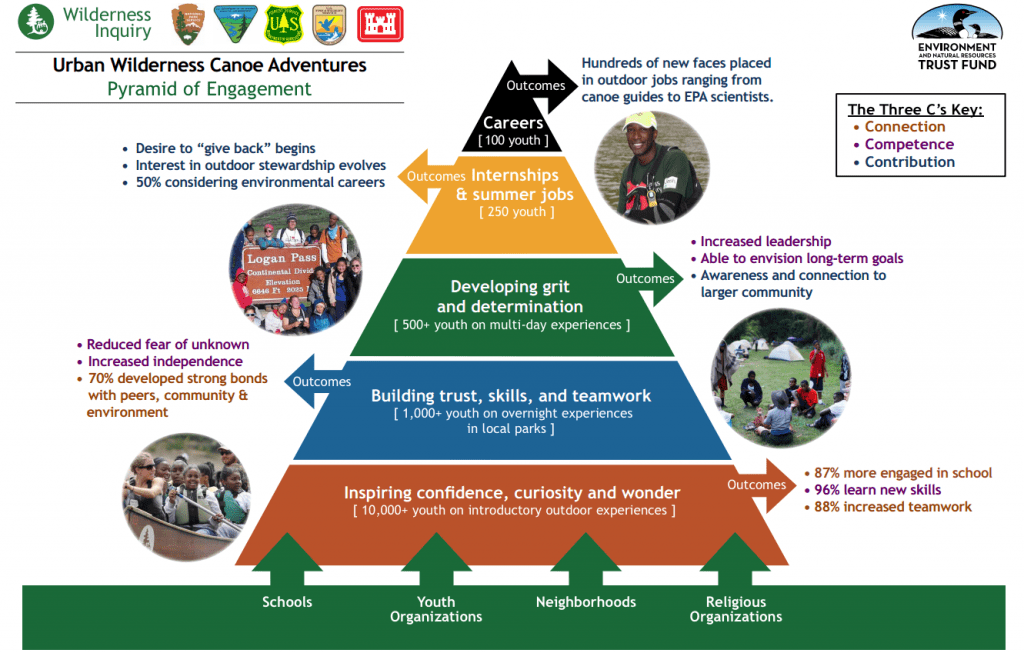From Guest Blogger Megan O’Hara, Youth Outdoor Employment Director:
“Who will prepare the scientists, technicians, engineers, entrepreneurs and global humanitarians [who] can rebuild our economy and society on a new and greener foundation? Who will educate citizens ready to master these new realities and ensure exemplary stewardship of our planet for now and for future generations?” – Martha Kanter, former Undersecretary for Education
A 2014 report on diversity in the environmental field issued a challenge to environmental agencies and organizations, as well as a path forward. Despite years of outreach, the green ceiling still holds at 12 to 14 percent minority representation in environmental NGOs, foundations and government agencies. While big improvements have been made in hiring and promoting women up the ranks, this has not extended to ethnic diversity.
The stakes are high for those working to inspire and launch environmental stewards for tomorrow. Our country is more racially diverse than ever and the environmental challenges are large and complex. Yet a recent event showed the power of mobilizing a vast and diverse talent pool for the future.
To Change Everything, We Need Everyone
The People’s Climate March showed that citizens across the world – represented by 400,000 marchers in New York alone— are ready to do what it takes to address the frightening urgency of climate change. The September 2014 People’s March demonstrated the power of concerted action by people of all ages and colors under a theme of “To Change Everything, We Need Everyone.” Because the Climate March was a “movement of movements” it succeeded in mobilizing more than 1,500 organizations, many of them representing people of color, indigenous peoples and those disenfranchised by poverty and other socioeconomic factors.

This is the kind of diversity that would greatly benefit environmental organizations and agencies that form the frontlines of the fight to create more sustainable and just policies and economies. Despite the fact that people of color and low-income citizens often bear the brunt of environmental damage and catastrophe, environmental leadership has remained largely white despite efforts made by many of these organizations.
The problem is especially noticeable in top leadership posts like executive director and board positions. While environmental organizations have increased diversity in internships, not many racial minorities are hired into full-time staff positions or promoted up the ranks.
Some of the attitudes and practices behind the green ceiling are explored in “The State of Diversity in Environmental Organizations: Mainstream NGOs, Foundations and Government Agencies,” by Dorceta Taylor, a professor at the University of Michigan’s School of Natural Resources and Environment.
A Green Insiders’ Club
In the report, Taylor found that most of the organizations and agencies surveyed recruit new employees through existing and informal networks. This reinforces familiar backgrounds and networks, rather than tapping into individuals from minority- serving institutions and organizations.
In her study, Taylor highlighted some strategies for developing and recruiting a more diverse talent pool that are not yet widely adopted. They include developing a pipeline for greater inclusion of minority and low-income residents, reaching out to and recruiting from minority serving institutions and organizations, and dedicating specific staff or board members to address diversity. This is a long-term game, requiring building of relationships and programs that serve diverse interests and needs.
Partners Building a Pipeline of Talent
At Wilderness Inquiry, work has been underway for five years to create such a talent pipeline. WI built on a strong history of serving individuals with disabilities to expand its reach to individuals facing socioeconomic barriers to full participation in our society. WI offers UWCA programming in the schools, currently reaching more than 13,000 middle and high school students in Minnesota and several thousand in 24 cities across the country via its traveling arm, Canoemobile. These programs connect thousands of urban youth to public lands in their own communities through hands-on learning adventures on both water and land.
This programming is created in close partnership with federal agencies like National Park Service and U.S. Forest Service; state and local partners like the MN Department of Natural Resources (DNR); Minneapolis and Saint Paul school districts, Minneapolis Park and Recreation Board and local and national NGOs like STEP UP Achieve, Right Track and Project WILD. All are working together to:
- Build an integrated system for experiential education that addresses the achievement and opportunity gap for disadvantaged youth
- Create a cadre of students who are inspired to further engage with the outdoors and build lasting social connections for their high school experience
- Introduce students to outdoor and environmental career paths and educational opportunities
- Establish a successful model for expansion throughout the school districts

WI’s “Pyramid of Engagement” program model offers a step-wise series of hands-on experiences that support academic achievement, build core personal skills and introduce students to outdoor industry and environmental careers.

Mayor Chris Coleman, a board member of Wilderness Inquiry, helped launch a Glacier National Park program with college-bound AVID students from St. Paul. Over several years, these trips have proven to be transformative with both recreational and career focus. These programs improve participants’ sense of themselves and their relationship to the world. WI and partners believe that experience, knowledge and empowerment are key to building collective action to address large-scale environmental and societal challenges.
To feed into the top of the Pyramid of Engagement, WI has formed an Outdoor Careers Advisory of 26 federal and state agency partners, city park boards, environmental organizations and horticulture/landscaping businesses and organizations that are committed to achieving a more diverse and representative workforce.
The issue of minority leadership in green organizations, though complex, remains an important order of business for us all. In its longtime role to promote social integration, WI has been led by individuals from all walks of life. For half of WI’s 36-year history, its board has been led by community leaders with disabilities. Yet, like most other outdoor and environmental organizations, cultural and ethic minorities have been underrepresented in its leadership.The work to expand social integration to talented young people facing socioeconomic barriers continues.


Leave a Reply